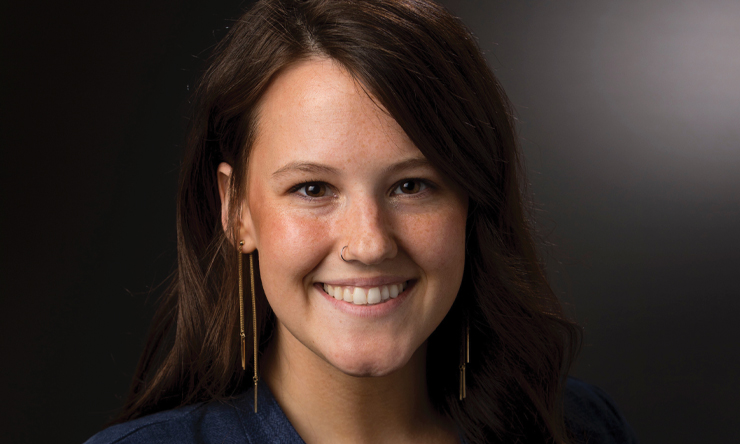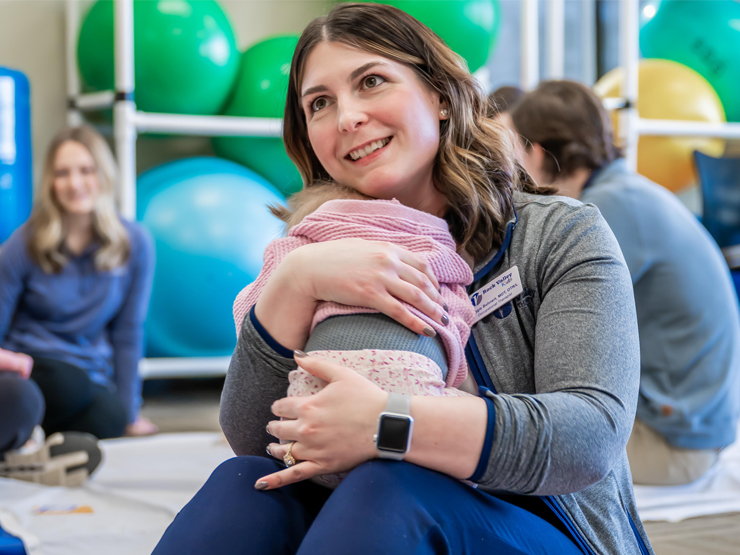Service impacts those who are served, but, as importantly, it affects the servants. Study Ambrosians who answer the call to serve and you begin to see how service becomes more than a feel-good activity. It becomes a way of life.
The Service of 'Being'
They include the hungry children who line up for lunches served out of the back of a truck.The faces of the poor and homeless are the faces of loved ones to St. Ambrose junior Molly Gabaldo.
They include men like Terry, who lost his wife in the 9/11 terrorist attacks on the Twin Towers in New York, and was himself badly hurt trying to rescue her. Plunged into grief and hopelessness, he struggled with post-traumatic stress disorder, depression and homelessness.
They include teenagers like Khalid, trying to live his life in the midst of a deadly gang war.
Gabaldo doesn't know when or how it happened exactly, but the nursing major from Bloomington, Ill., feels profoundly called to be with the poor. And whether she is handing out sandwiches or helping provide care at a community health center is not the main thing, she said. Being there, listening, connecting is.
"Doing this work, for the first time I have begun to understand how to love someone where they are," she said. "It's really more important than giving them lunch. It's about being willing to recognize the need in this world for kindness and peacemaking."
Gabaldo traveled to New Orleans-still far from healed after Hurricane Katrina-in 2010 and 2011. She didn't hammer a single nail. She just listened. "I was given the opportunity to learn how to serve through 'being' instead of 'doing,'" she explained. "And it was a difficult thing to learn."
Last December, Gabaldo was part of a St. Ambrose Campus Ministry group that a rode a late night "bread truck" through the most deprived areas of Chicago's South Side. What she encountered that winter night was like something out of a movie: children in various states of dress, people crowded around fires burning in trash barrels, reports of nearby shootings and knifings.
"It increased my passion and drive," she said of the experience, which led her to a summer month of volunteering with Chicago's Port Ministries. "It's humbling and beautiful to not only serve the poor, but to serve the poor from their doorstep and enter into a piece of their lives. It's a type of service of being, of genuine concern. It's partaking in a small piece of solidarity with those whom we serve."
Gabaldo said her experience at St. Ambrose has helped broaden her understanding of the definition and potential of peace and social justice.
"I was truly called here," she said. "Peace and social justice themes are worked into every class in this school. I love that."
Bee the Difference
Matt Tigges'08 and Katie Vogt Purcell '09, '11 DPT remember one scene in particular from the inaugural Bee the Difference Day in 2006, a day they helped co-organize as a Student Government Association (SGA) project.
Created to promote good will between students and campus neighbors, that day's projects ranged from cleaning neighbors' gutters to raking their yards. Tigges and Purcell were traveling from one project to another to check on progress and offer assistance to the students at work there.
One project stopped them.
"This lady needed her garage cleaned," Purcell said. "Her mother had owned the house and died. She was trying to sort through everything and was overwhelmed."
"It was a huge job," Tigges added. "The furniture was all mildewed. It had to be loaded onto trucks and lots of it taken to the dump."
"We ended up with 20 or 30 students helping," Purcell recalled. "Students kept coming over to help after they finished their other jobs. It was amazing. We got it done."
Bee the Difference Day has become a campus staple over the past six years, providing an easy opportunity for students to dip their toes into the idea of service.
"We saw people who weren't that into service get involved," Purcell said. "Afterwards, we heard from a lot of them. They thanked us for our part, and it made me realize how big an impact this program was having."
Emma (Crino) Folland '08 first proposed the Bee the Difference Day project to the SGA after hearing about a similar project at another school. She since has instituted a neighborhood service project at Washington Middle School in Clinton, Iowa.
"The best feeling I get is when once-skeptical students ask me if we can do this again next week," she said.
That's the hidden benefit. Service becomes habit-forming. And it changes the servant in ways they couldn't have foreseen.
"I like to believe I'm more humble," Tigges said. "People are all the same. We all need help at different times and in different ways. It takes all the judgment out of how you look at people. Instead of thinking, 'They probably put themselves there,' my reaction has changed to, 'Is there anything I can do to help?'"
Which perhaps is the best lesson of all. Small acts of service-holding the door open for the guy behind you; helping pick up dropped goods; even, as Tigges said, "just listening and talking"-count.
"Service is fundamental to Catholic education," Purcell said. "We are to live our faith in action. That means helping with the everyday stuff."
Taking Care of Each Other
As a young child, Willie Barney '90 lived among generous and caring family and community members. Although his family "didn't have much"-no one did in his quiet Mississippi community-they shared what they did have.
"If someone didn't have food, we'd send a plate down the street to them," Barney said.
As he grew, Barney began noticing differences between his neighborhood and others. He noticed, too, those differences existed in other towns, including Davenport.
"I remember driving up the Gaines Street hill toward St. Ambrose," he said. "I saw parts of my life going up the hill. I remember it like it was yesterday."
After graduation and 10 years in business, Barney moved to Omaha, Neb., for a marketing job. He again saw blighted neighborhoods butting up against more affluent areas. While his family had equipped him with a sense of neighborliness, SAU had equipped him with a sense of social justice and activism that prepared him to act. He began reaching out to faith, community and business contacts for help addressing the problem.
"We had seven people at the table in 2006," Barney said. "There were grassroots people, corporate people, non-profit people. We identified gaps in Omaha's housing, education, health and employment. We met every other Friday. Our first question was, 'What has stopped initiatives like this before? What will it take to make it succeed?'"
Those Friday meetings eventually created The Empowerment Network, an organization with 1,000 participants that leverages public and private partnerships throughout Omaha to help create healthy, stable neighborhoods, particularly in the North Omaha area.
"Omaha is a great city," Barney said. "There's a lot of wealth. We have five Fortune 500 companies. But we also have high unemployment and a lot of poverty, especially in North Omaha. There is a lot of African-American poverty there. You can't have a great city unless all zip codes are great."
In fact, Barney said North Omaha represents one of The Empowerment Network's greatest successes in the making. Home to a blighted two-block area that once was known as "the heart of jazz," the neighborhood is undergoing its first large-scale restoration project, a $12.2 million development with single-family housing, an arts and culture gallery and senior residences forming the core of the development.
Other partnerships with schools, faith-based communities, and social service agencies have resulted in improved graduation rates as well as an increase in minority students who enroll in college.
"One person, one school, one church, one business cannot do it all," Barney said. "But it's important for each person to do their part. Jim Collins '69 (St. Ambrose trustee emeritus) modeled that for me. He really encouraged me to give back to the community. I felt like my whole experience at St. Ambrose encouraged that. It was about people looking out for each other, whether on the football team or among the student body. Remarkable."
Service as Worship
Many wonderful moments occur during the school year for Professor of Education Rachel Serianz, PhD. But one of the best is when she hears a once-sheltered, timid student, fresh back from student teaching at an inner-city school, praise the experience.
Serianz should know. As a career educator who also serves as a eucharistic and music minister at Sacred Heart Cathedral, who counsels expectant single mothers and who sits on many university and parish committees, Serianz embodies service. "Some students are scared even to drive in inner-city neighborhoods," the professor said. "They find children who don't have enough to eat or wear, but who respond to loving and caring attention. They realize they can make a difference. That's a powerful thing to learn about yourself, that you can make a difference in another person's life. It's empowering service in the way I live?" she asked.
"Throughout my life, I have received from God an abundance of blessings, many of which were most definitely not deserved. In a sense, I am trying to 'pay forward' what God has given to me. Service is an act of thanksgiving. Service is a form of worship.
"We become more compassionate and caring," Serianz said. "We also become more aware of our limitations, or the limitations of what we can do to help another. There are some people we are not capable of helping. We can't feed and shelter everyone. But that old line-'We can't do everything, but we can do something'-is appropriate."
As for what, exactly, qualifies as service, Serianz echoed a familiar Ambrosian theme: caring presence counts.
"Sometimes I think that I take the call to service too lightly," she said. "Signing up for events and positions and putting in time working on projects: those are the easiest forms of service. Trying to interact with each person I encounter in a way that constitutes service is much more difficult. I struggle with that every day. And always will."
St. Ambrose students have a new opportunity to make that effort this fall with the "Pay it Forward" themed house. Serianz has accepted the request to serve as faculty advisor.
"I am truly honored that students asked me to help them realize their calls to service," she said. "I can hardly wait until we meet and begin brainstorming possible projects we will complete this year. I hope we come up with something radical!"
Share This Story



